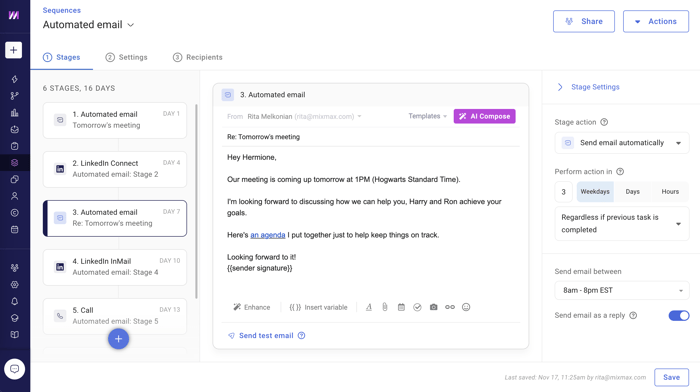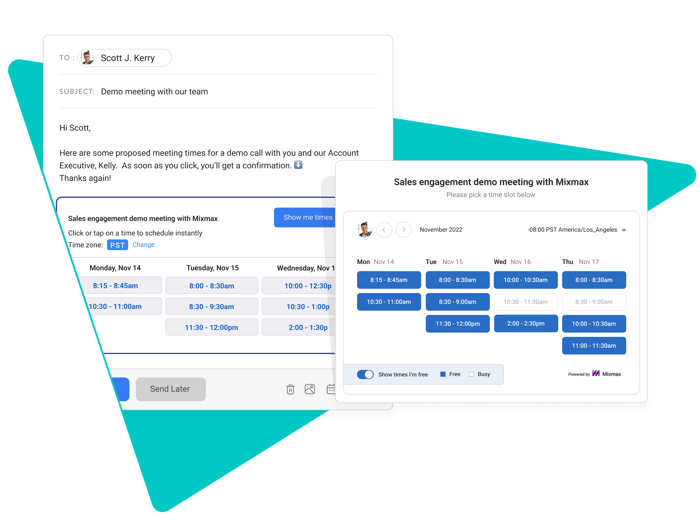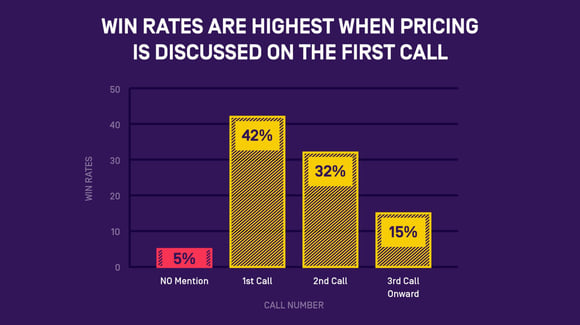June 27, 2023
5 Steps to Run a Successful Sales Discovery Process

- What makes a good sales discovery process?
- 5 steps to build an effective sales discovery process
- The round-up
- Signing off
- Frequently asked questions about sales discovery process
The sales discovery process is an essential step in learning how you can bring value to your potential customers. But all too often, in a hurry to get to the demo, it’s rushed through as part of qualification or even skipped altogether.
Biiiig mistake.
As Jacco van der Kooij, says, “Prescription without diagnosis is malpractice,” and this couldn’t be more true in sales.
Trying to pitch a product without first understanding prospect pain or how they’ll use your solution is a crutch that lower-performing salespeople lean on way too heavily.
A crutch that will come back to bite you when prospects drop out of the sales cycle without buying. Or worse, sign up, find the product doesn’t meet their needs, cancel the contract at the first opportunity, and badmouth you on review sites.
“Everyone is in a rush today to get to the punch line,” says Vincent Burruano, President of Vince Burruano Consulting Services. “Successful selling requires a time investment.”
How can you avoid these pitfalls?
We asked our sales team and other sellers to tell us:
What makes a good sales discovery process?
Here are our sales discovery must-haves:
Qualify leads first
First rule of sales prospecting: more haste, less speed.
(Second rule of sales prospecting: You do not talk about Sales Prospecting Club.)
Proper sales qualification makes discovery much easier: If you know they’re qualified, you can use discovery to go deep into their pain, etc. If not, you could end up confusing them, selling into the dessert, and wasting everyone’s time discussing problems you can’t actually solve.
Make it about them, not you
The biggest challenge with discovery is often the sales professional’s desire to skip it and get right to the solution.
Huuuuuuge mistake.
Even if the problem and solution are obvious to you, that doesn't mean they’re obvious to your prospects.
It's easy to talk about what your product does. You're trained to do that from day one.
It’s more difficult to understand what your customer wants and needs (and why they're even talking to you), then align your offering to meet that need.
Finding out what your prospect cares about allows you to become a trusted consultant who helps solve their problems. But you can only do this if you’re completely selfless about discovery.
That means not driving your own agenda. But instead being curious and asking many questions about their business so you can put together a tailored proposal. Having a solid, repeatable sales process that puts the prospect front and center also helps.
Bottom line, selling and building relationships is an uphill battle if you don’t genuinely care.
And the best way to demonstrate you care is to...
Sell solutions, not products
Prospects don’t buy product features; they buy a solution to their problems.
So it’s up to you to create an association in their minds between your product and a cure for their pain.
“People aren’t motivated by facts or logic, but by emotions,” says Vincent Burruano. “If you want them to change, you have to get them to see how changing will make them feel better.”
It’s your job to uncover and quantify pain, make sure they recognize it and understand how your value proposition relieves or eliminates it.
Of course, it helps a lot if you believe in your product. Sounds like a no-brainer, but you’d be amazed how many salespeople don’t.
Focus on the outcome
This is really all that matters: Is there alignment between your solution and their problems? If you end the discovery call knowing how you can help them, congratulations. You just ran a successful sales discovery process.
Remember, though, your prospect doesn’t necessarily know at this point that you can solve their problems, because you haven’t done a demo or solution validation yet.
So we’re back to that whole "it’s-not-about-you-it’s-about-them" thing.
Ask the right questions to get the right information
“A strong discovery process involves a flowing, back-and-forth conversation with the prospect about their issues and circumstances,” says Daniel O'Dowd of Sales Enablement Collective. “You want to avoid it feeling like an interview, or worse, an interrogation.”
At this point, it’s all about asking the right sales discovery questions to get them to open up.
“Develop a list of questions that elevate the conversation,” says Vincent Burruano. “You need to demonstrate that you have expertise and experience in the area you’re selling in. Be properly prepared to have a business conversation with stakeholders that demonstrates your higher-level understanding of your role–to solve business problems–not simply to sell something.”
“Don't be afraid to ask hard questions right away,” says Jesús Vargas, Founder & CEO of Low Code Agency. “Those are usually related to price, timeline, and expectations.”
Speaking of price, Gong recently released this delicious nugget of information about how discussing pricing during the first call (discovery) increases win rates by 10%.
It can also help to use a discovery call checklist or sales framework to get valuable insights into your prospect’s needs if they match your company’s criteria for what makes a sales opportunity.
Some sales discovery frameworks include:
- POWERFUL: which stands for Pain, Opportunity Costs, Wants, Executive Level Influence, Resources, Fear of Failure, Unequivocal Trust, and Little Things. This is a framework created by Marcus Chan, who explains it in detail in the interview below:
- SPICED: which stands for Situation, Pain, Impact, Critical Event, and Decision.
- SPIN: Situation, Problem, Implication, and Need-payoff.
- MEDDIC: Metrics, Economic Buyer, Decision Criteria, Decision Process, Identified Pain, and Champions and/or Competitors. (See below for how to apply MEDDIC to post-call follow-up using Mixmax customizable email templates).
This video from Pipedrive nicely explains how the MEDDIC framework can help you run an effective sales discovery process.
That said you should always...
Build your own rhythm, don’t stick to the script
Good discovery—and good sales in general—is never about checking off a list of open-ended questions prepared by your sales manager, marketing VP, or SDR manager.
It’s about understanding your prospect’s business drivers and personal motivations. That means you need to keep it a bit loose and be prepared to run with things (without completely losing control of the conversation, of course).
Successful selling is all about building trust and rapport, which is easier to do if you don’t sound like a robot reading discovery call questions from a script.
Sales prospecting techniques like listening more than you talk, and coming off as natural and conversational will get you a lot further.
Which brings us to…
Don’t phone it in
Occasionally in B2B sales, you’ll meet a prospect who’s resistant to doing discovery. They get annoyed about having a second call after qualification and just want to move forward to the product demo.
When this happens, you can thank every sales rep they ever met who put them through a 30-min discovery call only to follow up with a bland, unpersonalized, vanilla, one-size-fits-all demo they could have sent over as a YouTube link.
Result? The prospect feels discovery was wasted time that brought them zero value.
And they’re right.
Colossal—nay—gargantuan mistake! (Stop us when that gets old.)
Of course, we know you’ll pull out all the stops to ensure a good discovery call where they see the value and feel heard.
Which involves:
- Telling your prospects honestly what you plan to do in the sales process so their expectations are set.
- Doing what you promised.
- Explaining the purpose of discovery.
- Demonstrating you understand their pain and industry by using their language.
- Showing them a solution that speaks to their pain.
Practice makes perfect
Before Beyonce played Coachella, she reportedly rehearsed for eight months.
Let’s take a moment to think about that. Eight. Whole. Months.
Why are we telling you this? So you can’t complain when we tell you to rehearse your discovery meetings.
Running through your questions and the agenda in advance will make you feel more confident, which helps build rapport. You can also work with a mentor or partner, and listen back to previous discovery calls (your own and others’) using a conversation intelligence tool like Gong to analyze performance.
Take the long view
If you think you need to get all your discovery done in one 30-minute phone call early in the sales cycle, you’re going about it all wrong.
“People won’t want to make a significant investment if they don’t like and trust the sales professional,” says Vincent Burruano. “This often takes time to develop. Depending on the size and complexity of the product or service you offer, the discovery process may require multiple meetings with various stakeholders over many months or longer. Each sales process is different, but the need to build mutually beneficial relationships is consistent.”
Discovery isn’t a single event at a single point in time, but a process that runs across the sales cycle, right through to customer success and renewal.
Think beyond just closing the deal, and focus on what will make this a lasting, mutually beneficial, long-term relationship.
You can even open every call with mini-discovery-style questions to identify problems and new opportunities, especially when new people are looped in
5 steps to building an effective sales discovery process
Here’s how to run a great discovery call the Mixmax way:
1. Pre-call preparation & planning
- Create a pre-call planning checklist to keep you on track and on top of everything.
- Research your prospect company and contacts using LinkedIn, Twitter, their company website, Google, 10K and 10Q reports (if publicly available), industry review sites, etc.
If you’re an AE and the SDR did the qualification, you still need to do your own pre-call research to understand their challenges and go into discovery ready to understand the business, their drivers, and how you can help.
- Share your research with any internal roles attending (VP, PM, support, etc.)
- Look for company initiatives or priorities that you can tie your value into.
- Assume an org chart and be prepared to verify it on the call.
2. Setting up the meeting, pre-call logistics
- Share the agenda with prospects in advance and make sure it’s included in the meeting invite.
- Set up an automated reminder email in Mixmax to go out 24 hours in advance to double-check they’re still planning to attend (as shown below).

- Share materials to educate them about you and your product prior to the call so they have a sense of who you are. This helps make the most of your time together. Short videos, articles, blog posts, use cases, etc. are all good and, thanks to Mixmax integrations, can easily be shared without you having to leave your Gmail inbox.
3. Create a notes template for every call
This should include:
- The agenda (eg. current situation, pain/issues with the current situation, how they make purchase decisions, etc).
- What you know so far, even if that’s very limited.
- What you’d like to understand in more detail.
4. During the meeting
- Open the meeting by establishing context—what’s going to happen on the call—and what the value is for them. Also, explain that you’ll leave time at the end of the call to evaluate progress if there’s a mutual fit.
- Summarize information gathered in previous interactions, using their language. Get agreement or confirmation on what you know so far, so you can then go deeper.
- Ask pointed, relevant, open-ended sales discovery questions to “peel the onion,” understand their challenges, and find out who you need to loop into the next call. Learn how to probe deep, looking past initial responses to uncover their true motivations. And never, ever sell into the dessert by asking questions that are irrelevant, convoluted, or confusing.
- Seek confirmation/validation along the way. Again, using their language.
- Refer back to your agreement to evaluate progress, and fix a date for the next meeting (demo) right there and then. If you’re using Mixmax, you can also send an email with your availability directly in the email (which increases meetings booked by 57%) to make it easy for everyone.

5. Post-call follow up
- Send a recap of the relevant and important topics discussed (especially pain, process, and timing), and next steps. Set this up as part of your prospecting sequence in Mixmax so it goes out at the right time after the meeting, and so you get an alert when people open your email.
- Detail specific actions items identified on the call, with responsibilities and timelines for each one.
- Ask them to reply by email to verify you got everything right.
If you’re using the MEDDIC framework, check out this cool video from Zen Lenon showing how to use Mixmax to send a follow-up email that covers all the framework bases.
Skip to 12:00 mins to see how Zen Lenon uses Mixmax customizable email templates to create a repeatable MEDDIC follow-up summary
The round-up
Running a successful sales discovery process is an essential step in finding out how you can bring value to potential customers.
Here’s how you do it:
- Qualify leads properly first so you can go deeper in discovery.
- Make it about your prospect, not you.
- Sell solutions, not products.
- Focus on the outcome of the call, and finding fit.
- Rehearse your calls, ask open-ended questions, and use a checklist or framework (if appropriate), to get the information you need. But don’t be tied to your script.
- Don’t waste their time in discovery only to show them one-size-fits-all demo.
- Think of discovery as an ongoing process, and look for ways to build a long-term relationship.
- Research and prepare ahead of the call, and create a presentation.
- Share the agenda in advance, and send an automated reminder email.
- Outline what’ll happen on the call, summarize and get validation throughout, and establish the next steps.
- Follow up with a summary email detailing action items and responsibilities, and ask them to confirm.
Signing off
Say “salesperson” to a lot of people and the first thing that comes to their minds is a sleazy old car vendor who’s only interested in tricking them into buying something they don’t need or want. Often, by lying or hiding something during the sales process.
Now, we know this beautiful profession of ours is waaaay better than that. Good salespeople don't need to fool their prospects and can negotiate in good faith because they've earned their trust.
It all starts with a solid sales discovery process and sales reps who go outside their comfort zone to put the buyer front and center, understand their problems, and be eternally curious about how they can help. They know you can’t skip or rush this essential step, or pitch before you understand a prospect’s pain and needs.
They also know running a successful sales discovery process is a lot easier when you get a little sales engagement help from Mixmax, especially if you’re operating out of a fast-growing company using Salesforce and Gmail.
Frequently asked questions about the sales discovery process
What is a discovery call in sales?
A discovery call in sales is a meeting between a sales representative and a prospect that happens after qualification. During a discovery call, the seller gathers information about the buyer’s pain, needs, decision-making process, and other factors to determine whether they are a good fit for their product.
What are the core elements of effective sales discovery?
The core elements of an effective sales discovery process are pre-call practice and preparation; asking the right open-ended questions; having an agenda for the meeting; establishing context and next steps; making it about the prospect, not the seller; and timely post-call follow-up.
Why does the sales process have a discovery stage?
The sales process has a discovery stage because it’s essential to understand your prospect’s pain, needs, and challenges to identify where you can bring value. And so you can tailor your proposal before you pitch your solution. The purpose of a discovery call is to build on the qualification stage and establish whether the opportunity is worth pursuing.
How do I run a discovery sales call?
You can run a sales discovery call by summarizing previous meetings and information gathered; asking open-ended questions to delve deeper; using a framework or checklist to get the information you need; asking for confirmation or validation along the way by summarizing in their language, and agreeing on the next steps / booking the next meeting before ending the call.
Thanks for insights and inspiration to:
- Jacco van der Kooij, Founder of Winning by Design
- Vincent Burruano
- Jesus Vargas
- Yang Zhang, Co-founder of Plasmic
- Allan Stolc, Founder and CEO of Bankly
- Daniel O'Dowd Copywriter/Content at Sales Enablement Collective



.png?width=600&height=314&name=6%20Non-Boring%20Discovery%20Call%20Tactics%20(On-demand%20recording).png)

.png?width=450&height=250&name=Episode%20Graphic%20(1).png)
